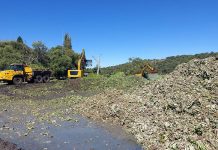Why do you think South Africa’s renowned biodiversity is in danger?
The country is exceeding its biological carrying capacity. This means that fewer ecosystem goods and services are produced than we consume annually. We’re eating into our natural capital resource base every year and reducing the natural capital’s ability to generate any further ecosystem goods and services. The fragility of South Africa’s natural heritage is reflected in the declaration of three biodiversity hotspots – there are only 34 in the whole world – and eight World Heritage Sites within its borders. The key point about hotspots is that their unique biota is under extreme threat of extinction. This is worsened by climate change and the fact that South Africa is already importing much of its water. This country ranks in the top 25 on the greenhouse-gas emitting list. India, despite having a population 25 times bigger than ours, is “cleaner” on a per unit basis. All these pressures place our biodiversity at significant risk.
What has caused this situation?
Our economic development has become unsustainable. We will have to reduce poverty – with its accompanying factors of malnutrition and loss of self-esteem and dignity – develop economically, and manage our natural capital base more prudently, within the constraints of the supply of water and energy as limiting factors. Poverty disease, water insecurity, energy insecurity and environmental degradation have become the Big Five Plagues, the combined effect of which is devastating the population’s quality of life as well as the integrity of the natural capital base. This pushes decision-makers to hasten economic development even more in the hope of alleviating poverty against a background of unfulfilled political promises and failing service delivery. We have to safeguard against short-term solutions that could have counterproductive long-term impacts.
Why are our environmental laws not used to protect our natural capital?
South Africa’s constitution protects the rights of future generations, actively promotes conservation and ecologically sustainable development and makes a strong statement against environmental degradation and pollution. The constitution is supported by a range of acts and policies that are truly world-class from an environmental point of view – if enforced and monitored. However, it seems as if contradictory government policies and objectives have priority.
There’s a kind of political schizophrenia between the constitution and a range of policies on the one hand, and the Accelerated and Shared Growth Initiative for South Africa (ASGISA) on the other, and it’s not one that can be easily cured. For example, six of ASGISA’s 11 provincial turnkey projects are extremely resource-intensive. Included is large-scale plantation forestry using alien species, water-intensive mining projects, especially platinum, biofuel production and a few commercial irrigation farming and livestock schemes. Agricultural, livestock, and mining projects are water and energy-intensive, require large areas of land and compromise biodiversity and environmental conservation.
To avert a situation where the marginalised, unemployed, disenfranchised and disillusioned poor gain control over the nation, government has enlisted the help of big business. It would seem as if neoclassical economists, government and big business have formed an “iron triangle” of power to counter ideologies that don’t conform to theirs. And it’s the environment and minority groups that are being squashed between the iron triangle and the demand for rapid economic growth. ecologically sustainable development exist, but they call for political will and determination. And we must view the natural environment as a productive asset – as stocks of capital, which render a flow of services. Another challenge is to create proper institutions, well-functioning markets aided by improved price signals, the ability to trade and the ability to manage risks.
How can we solve our water and energy problems?
To reduce a nation’s ecological footprint, there are two options: either reduce resource extraction or increase the supply of the resource. On the demand side, appropriately designed environmental taxes on both water and energy can have pro-poor, pro-growth or development and pro-environmental benefits. We could levy a tax on the consumption of water and then recycle the revenue gained from it back into the economy in a way that will improve the plight of the poor, create employment, stimulate economic growth and reduce water consumption. It is also possible to introduce cap-and-trade models whereby the quantity of water abstracted is capped and the water available for consumption is traded among the participants. In the case of energy, revenue from either a carbon tax or a coal consumption tax can also be recycled and even used to stimulate the introduction of more resource-efficient technologies.
How will farming have to change to fit into the new picture?
With regional cooperation increasing, farmers could relocate to where the water is, instead of relocating the water to where the farmers are. This is already happening, with some enterprising South African farmers moving to Zambia, Nigeria, and Mozambique. Not only will this release the pressure on local water resources, it could also contribute to food security across the region and improve stability. As for farming in South Africa, an integrated system, in which waste is recycled to produce energy and where water is managed within a closed system, is quite possible. The aim should not simply be to use resources more efficiently.
We need technology substitution such as the replacing centre pivot systems with drip irrigation. One of the major criticisms of the introduction of such technologies is the upfront capital costs. Here, government could provide incentives to stimulate the transition to improved technologies. Some of the additional water charges could even be used for this.
From the supply side, payments for ecosystem goods and services offer unique opportunities for practical and integrated local level conservation, ecosystem management and sustainable local economic development. An alternative supply-side measure is the restoration of natural capital as an extended public works programme. Such restoration activities provide direct employment and education opportunities and leave a lasting legacy. Contact Prof James Blignaut on 084 720 4127, e-mail [email protected] or visit www.jabenzi.co.za / www.rncalliance.org, |fw








